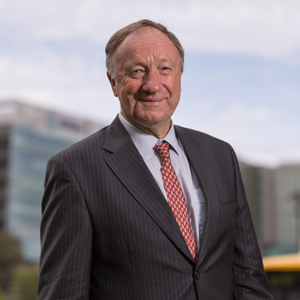Queue starts forming for Optimum Pensions
We’ve known about it for years, but D-Day is now close at hand for big super funds. An estimated $500 billion is, potentially, going to leave the system over the next two years, according to an APRA estimate. Funds can longer afford to be complacent about their business.
David Orford, an actuary who made his fortune through administration software, is on a mission to alter the landscape for retirees. He launched Optimum Pensions a year ago and has been refining ‘Real Lifetime Pension’ after many consultations with the industry. He says there are currently six clients “moving towards implementation”.
Orford sold Financial Synergy to IRESS for $90 million in 2016 and put most of his share of the money into the Orford Foundation to fund philanthropic endeavours. The foundation holds his stake in Optimum Pensions.
“We believe that the old account-based pensions are dead,” he said last week. “They are not in members’ best interests.” While reluctant to put a figure on it, he thinks that the Real Lifetime Pension, which is coupled to an underwriting contract with Hannover Re, can extend the time funding a person’s retirement by 20 per cent. “The longevity protection in our product has a huge benefit,” he said. “It’s designed to offset inflation until death.”
Peter Rowe, the firm’s general manager, said that with the Royal Commission behind them, big funds had started to re-engage and plan for the next budget cycle. “We’ve developed a calculator which we’ve shown to planners and funds which makes it very easy to show a member what his or her position will be.”
Orford says that Optimum’s research shows that people want three main things in retirement: enough money, an income stream and good health.
One of the issues with some calculators is that they are based on the Australian Government life tables, which tend to be out of date given the speed with which medical science has helped extend people’s lives.
The APRA numbers, as at February 2017, show that there are about 500,000 members aged between 55-65 (the preservation age) with a total of $523 billion in their accounts. Orford says funds have an opportunity to retain their members long-term. There is a 25 per cent probability the average member will live beyond 90.
The Orford Foundation funded a research paper by the Actuaries Institute of Australia and Rice Warner that showed that advisors who rely on the static life expectancy results the Government Actuary’s Life Tables dramatically understate reality. For instance, using the Government Actuary’s ’25-year improvement factors’, by the time a 65-year-old reaches 75 the mortality rate for a 75-year-old will already be about 40 per cent less than it was when the tables were produced. Basically, your life expectancy gets longer the longer you live because the mortality rates decrease over time.
– G.B.










